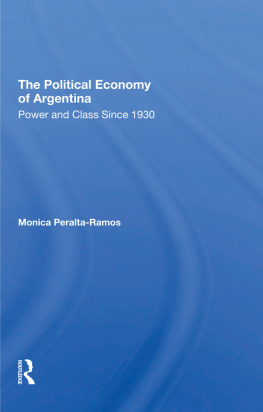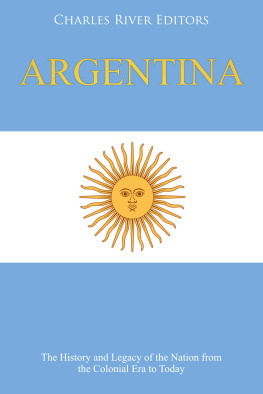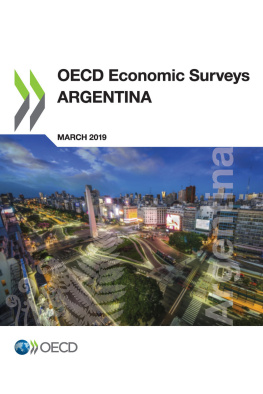Jonathan C. Brown - A Brief History of Argentina
Here you can read online Jonathan C. Brown - A Brief History of Argentina full text of the book (entire story) in english for free. Download pdf and epub, get meaning, cover and reviews about this ebook. year: 2003, publisher: Facts on File, genre: Politics. Description of the work, (preface) as well as reviews are available. Best literature library LitArk.com created for fans of good reading and offers a wide selection of genres:
Romance novel
Science fiction
Adventure
Detective
Science
History
Home and family
Prose
Art
Politics
Computer
Non-fiction
Religion
Business
Children
Humor
Choose a favorite category and find really read worthwhile books. Enjoy immersion in the world of imagination, feel the emotions of the characters or learn something new for yourself, make an fascinating discovery.
- Book:A Brief History of Argentina
- Author:
- Publisher:Facts on File
- Genre:
- Year:2003
- Rating:3 / 5
- Favourites:Add to favourites
- Your mark:
- 60
- 1
- 2
- 3
- 4
- 5
A Brief History of Argentina: summary, description and annotation
We offer to read an annotation, description, summary or preface (depends on what the author of the book "A Brief History of Argentina" wrote himself). If you haven't found the necessary information about the book — write in the comments, we will try to find it.
A Brief History of Argentina — read online for free the complete book (whole text) full work
Below is the text of the book, divided by pages. System saving the place of the last page read, allows you to conveniently read the book "A Brief History of Argentina" online for free, without having to search again every time where you left off. Put a bookmark, and you can go to the page where you finished reading at any time.
Font size:
Interval:
Bookmark:

OF ARGENTINA
SECOND EDITION
JONATHAN C. BROWN
University of Texas at Austin

iv
v
v
vii
ix
1 1
Appendixes
Basilica of Salta cover
xii
LIST OF MAPS
LIST OF TABLES AND CHARTS
 have benefited immensely from a wealth of literature on the history of Argentina in both Spanish and English. The Argentines have developed one of the most lively and professional historical traditions in Latin America, and they have a talent for seeing themselves with clarity and wisdom. They practice their studies at a number of fine institutions of higher learning and research institutes both in Argentina and abroad. Moreover, the Argentine historical community has welcomed foreign scholars to its archives and libraries so that the English-language literature ranks among the richest for any country of Latin America.
have benefited immensely from a wealth of literature on the history of Argentina in both Spanish and English. The Argentines have developed one of the most lively and professional historical traditions in Latin America, and they have a talent for seeing themselves with clarity and wisdom. They practice their studies at a number of fine institutions of higher learning and research institutes both in Argentina and abroad. Moreover, the Argentine historical community has welcomed foreign scholars to its archives and libraries so that the English-language literature ranks among the richest for any country of Latin America.
In addition, my students and former students assist me-indeed, they challenge me-in staying on top of the latest research. They themselves have contributed five doctoral dissertations and 19 master's research projects about Argentine history that have enriched my knowledge and understanding of that country. They will recognize in these pages where I am beholden to their research. I owe special thanks to Joan Supplee, Gil Ramirez, Ricardo Salvatore, Rukhsana Qamber, Greg Hammond, and Adrian Hawkins for their doctoral work. Among those who have turned out fine master's projects are Kevin Kelly, Barbara Boczek, John Rochford, Andrea Spears, Lisa Cox, Barbara Pierce, Alfredo Poenitz, Yao-Sung Hsiao, Matthew Faddis, Wayne Magnusson, Jesus Gomez, Byron Crites, Cyrus Cousins, Jen Hoyt, Sabina Mora, Brian Teplica, Peter Toot, and Josie Engels. I am indebted to Maria Celina Tuozzo for her keen insights on Argentine labor history. Michael Snodgrass graciously permitted me to draw from his superb analysis, especially on the relationship between Juan Peron and his working-class followers, which appears in chapter 8.
In Buenos Aires, I profited from the expert assistance of Daniel V Santilli of the Instituto de Historia Argentina y Americana "Dr. E. Ravignani." He searched among several different sources in Buenos Aires to find many of the illustrations that grace this book. During the past decade, I have corresponded frequently with Torcuato Di Tella, Ricardo Salvatore, and Cuatro Tolson, who keep me abreast of events. I benefited also from the Reuters news dispatches from Argentina that were written by a former student, Brian Winter. In addition, Gil Ramirez has shared jokes and insights over the years, and Byron Crites donated a critical labor document. Li He gave me the statistics on Chinese-Argentine trade; Jen Hoyt and Cyrus Cousins contributed photos and illustrations.
I have been fortunate to have had the advice and counsel of my own in-house editor and muse, Lynore Brown. Finally, Josie Engels served as my research assistant for this second edition. Her attention to detail keeps me informed of the most important twists in Argentina's current events. Unless otherwise noted, translations that appear in this book are my own. All the above contributed to making this a better book, though they cannot be faulted for its shortcomings.
THE ARGENTINE RIDDLE
 ust a year ago, when I accepted the commission to update A Brief History of Argentina, I thought that I would be able to finish the second edition on a positive note. The first edition had concluded with an analysis of the 2001 economic crisis, during which the country defaulted on its foreign debt, citizens lost about two-thirds of their bank deposits, and four different presidents served in the last two weeks of December. Last year, the Argentine economy had rebounded and was producing annual growth rates of 8 percent. Then bad news hit Argentina. Wall Street suffered a near financial collapse, and world markets began to purchase fewer Argentine agricultural products. As President Cristina Fernandez de Kirchner said, "We were registering the most important growth in the last 200 years ... when suddenly the world appeared and it complicated our lives" (Winazki).
ust a year ago, when I accepted the commission to update A Brief History of Argentina, I thought that I would be able to finish the second edition on a positive note. The first edition had concluded with an analysis of the 2001 economic crisis, during which the country defaulted on its foreign debt, citizens lost about two-thirds of their bank deposits, and four different presidents served in the last two weeks of December. Last year, the Argentine economy had rebounded and was producing annual growth rates of 8 percent. Then bad news hit Argentina. Wall Street suffered a near financial collapse, and world markets began to purchase fewer Argentine agricultural products. As President Cristina Fernandez de Kirchner said, "We were registering the most important growth in the last 200 years ... when suddenly the world appeared and it complicated our lives" (Winazki).
Today's crisis does not appear to be replicating the 2001 episode, for so far it is producing fewer dislocations. Nonetheless, the present-day riches-to-rags story, in fact, has so many historical precedents, it always brings up the same question: What's wrong with Argentina? Their fellow Latin Americans like to tell a joke about the Argentines. "Would you like to know how to become rich overnight?" they ask. "It's quite simple. Just buy an Argentine for what he's worth and sell him for what he thinks he's worth."
The joke, often repeated among Argentines themselves, seems to sum up one aspect of the "Argentine Riddle." The country once had one of the most vibrant economies in the world. In the 1920s, Argentines compared themselves favorably to France in terms of economic wealth and individual well-being. Children of the Argentine landowning class were known in London and Paris as the original jetsetters of the early 20th century. Now, Argentines count themselves among the underdeveloped nations of the world. Great-grandchildren of European immigrants now seek to repatriate themselves to the homelands of their great-grandparents. Argentines themselves are deeply disappointed about the supposed gap between the country's possibilities and its intractable problems, such as economic boom and bust, chronic unemployment, political violence, and sharp class antagonisms. This is the Argentine Riddle.
What is wrong with Argentina? Argentina has a population that ranks among the most educated and skilled in Latin America, and its citizens have made major contributions to the world. Illiteracy scarcely exists among even the poor and working-class citizens, and Argentina's middle class historically has been large and politically engaged. Moreover, the humid and temperate Pampas are among the largest and most fertile plains areas in the world. With a topsoil running 50 feet deep in some places, the Pampas easily support rich grazing for cattle and sheep and produce bountiful harvests of wheat, corn, soybeans, and sunflower seeds. The interior provinces foster hundreds of world-class vineyards, fruit farms, sugar plantations, a timber industry, and cultivation of the famous yerba leaves from which Argentines love to brew the tea known as mate. Today's wine connoisseurs have recognized malbec from Mendoza to be among the great varietal wines of the world. The country's second-largest city, Cordoba, has spawned industrial development with its metallurgical and automobile industries; its third-largest city, Rosario, dominates a vibrant river shipping industry that connects Atlantic commerce to seven Argentine provinces, Paraguay, and parts of southern Brazil. Argentina has cooperated with neighboring countries to develop the hydroelectric potential of the many rivers of the Parana River basin, most notably near the Iguazu (Iguazu in Brazil) Falls. In the south, the Patagonian region attracts tourists fascinated by the natural beauty of Andean lakes, the whales and walruses of the Chubut coastline, the glaciers of Ushuaia, and the ski slopes of Bariloche. Walt Disney gained inspiration for his movie Bambi in Patagonia's mountain forests, and U.S. president Dwight Eisenhower delighted in playing on the world-famous golf course at the Hotel Nahuel Huapi. Tragically, the majestic glaciers of the Tierra del Fuego are melting at an alarming rate.
Font size:
Interval:
Bookmark:
Similar books «A Brief History of Argentina»
Look at similar books to A Brief History of Argentina. We have selected literature similar in name and meaning in the hope of providing readers with more options to find new, interesting, not yet read works.
Discussion, reviews of the book A Brief History of Argentina and just readers' own opinions. Leave your comments, write what you think about the work, its meaning or the main characters. Specify what exactly you liked and what you didn't like, and why you think so.











